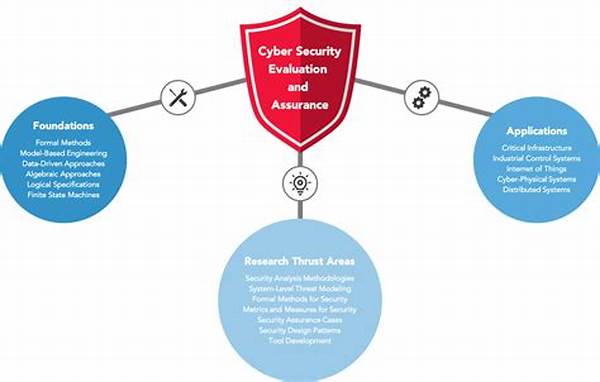The evolving landscape of academic research has invariably led to a significant reliance on digital technologies. With this shift, the importance of cybersecurity in academic research cannot be overstated. Protecting sensitive data, maintaining the integrity of research findings, and ensuring the privacy of participants are paramount. As academic institutions continue to advance in technology-driven research, the need for robust cybersecurity measures becomes increasingly acute. This article delves into the significance, challenges, and strategic approaches to enhancing cybersecurity in the academic research arena.
Read Now : Applications Of Semantic Indexing Algorithms
The Significance of Cybersecurity in Academic Research
Cybersecurity in academic research is of utmost importance, as it safeguards the integrity, confidentiality, and availability of critical data. Academic institutions are treasure troves of information, often containing sensitive data ranging from groundbreaking research findings to personal data of participants. Maintaining cybersecurity ensures that this information is protected against unauthorized access or theft. Furthermore, researchers rely on accurate and untampered data to draw conclusions; thus, cybersecurity helps sustain the credibility of academic work. As cyber-attacks become increasingly sophisticated, academic institutions must prioritize the development and implementation of robust security measures. Initiatives such as regular security audits, employee training, and the use of advanced technology can minimize vulnerabilities and protect valuable intellectual property. Ultimately, the integrity of the academic research process is heavily reliant on the strength and efficacy of its cybersecurity framework.
Challenges in Cybersecurity for Academic Research
1. Data Sensitivity: Cybersecurity in academic research must address the protection of sensitive data, ensuring confidentiality and integrity at all times.
2. Limited Resources: Academic institutions often face budget constraints, making it challenging to allocate sufficient resources for cybersecurity in academic research.
3. Evolving Threats: The dynamic nature of cyber threats necessitates ongoing adaptation and enhancement of cybersecurity in academic research.
4. User Education: Ineffective training of faculty and students can lead to lapses in cybersecurity in academic research practices.
5. Integration Complexity: Incorporating cybersecurity measures into existing academic research systems often involves complex integration challenges.
Strategic Approaches to Enhance Cybersecurity
In the realm of academic research, integrating robust cybersecurity measures is critical to safeguard valuable intellectual assets. One of the primary strategies includes conducting regular risk assessments to identify potential vulnerabilities. By understanding the threat landscape, academic institutions can prioritize their security efforts effectively. Additionally, fostering a culture of cybersecurity awareness among researchers, faculty, and students is vital. This involves regular training sessions aimed at educating individuals on best security practices and emerging threats. Another pivotal approach is to leverage advanced technologies such as encryption and intrusion detection systems that provide an additional layer of protection. Collaboration with industry experts and adherence to national and international security standards also play a significant role in reinforcing cybersecurity in academic research environments. Moreover, establishing incident response protocols ensures that institutions are prepared to swiftly address and mitigate cyber incidents, thereby minimizing potential damage to academic endeavors.
Implementing Effective Cybersecurity Protocols in Research
1. Risk Assessment: Conduct comprehensive risk assessments regularly to evaluate the security posture related to cybersecurity in academic research.
2. Awareness and Training: Empower researchers with knowledge and skills to navigate cybersecurity challenges in academic research effectively.
3. Technological Solutions: Employ encryption, firewalls, and intrusion detection systems to bolster cybersecurity measures in academic research environments.
4. Policy Development: Formulate and enforce stringent cybersecurity policies to regulate how data is accessed, shared, and stored in academic research activities.
Read Now : Publishing Academic Papers In Contemporary Analysis Journal
5. Incident Response Plans: Develop robust response strategies to quickly and effectively address cybersecurity breaches within the academic research framework.
6. Regular Audits: Conduct periodic audits to ensure compliance with cybersecurity protocols and identify areas for improvement in academic research settings.
7. Cross-Disciplinary Collaboration: Collaborate across different academic disciplines to foster innovative solutions for cybersecurity challenges in academic research.
8. Vendor Management: Implement stringent criteria for vendor selection to ensure they meet cybersecurity standards necessary for academic research partnerships.
9. Data Management: Ensure robust data management practices that align with cybersecurity protocols to protect research data integrity.
10. Compliance and Standards: Adhere to national and international standards to ensure best practices are followed for cybersecurity in academic research.
The Future of Cybersecurity in Academic Research
As technology continues to evolve, so too will the landscape of cybersecurity in academic research. The integration of AI and machine learning presents both opportunities and challenges for enhancing cybersecurity measures. On one hand, these technologies enable more sophisticated threat detection and response mechanisms, allowing institutions to effectively safeguard their cyber infrastructure. On the other hand, cybercriminals are also leveraging advanced technologies to exploit vulnerabilities. Therefore, academic researchers must continuously innovate and adapt their cybersecurity strategies to stay ahead of potential threats. Furthermore, the growing interconnectedness of global academic networks necessitates international collaboration to establish standardized cybersecurity protocols. By sharing knowledge and resources, academic institutions can collectively enhance their cybersecurity posture. In conclusion, the future of cybersecurity in academic research is contingent upon proactive adaptation, collaboration, and the continuous pursuit of cutting-edge technological solutions.
Conclusion: Emphasizing Cybersecurity in Academic Research
In today’s digital age, the emphasis on cybersecurity in academic research has never been more paramount. As research increasingly relies on digital platforms, safeguarding data integrity, privacy, and confidentiality becomes a critical priority for academic institutions worldwide. Recognizing the significant impact of cybersecurity breaches on research outcomes and reputation, it is essential that educational institutions allocate sufficient resources and expertise to strengthen their cybersecurity frameworks. While challenges persist—ranging from resource constraints to complex integration issues—it is crucial that institutions remain steadfast in their commitment to fortifying their cybersecurity measures. Ultimately, the pursuit of robust cybersecurity strategies not only protects vital research data but also enhances the credibility and impact of academic endeavors on a global scale. In this dynamic landscape, the academic community must continue to adapt, innovate, and collaborate to effectively address emerging cybersecurity challenges and ensure the continued protection of invaluable scholarly contributions.
